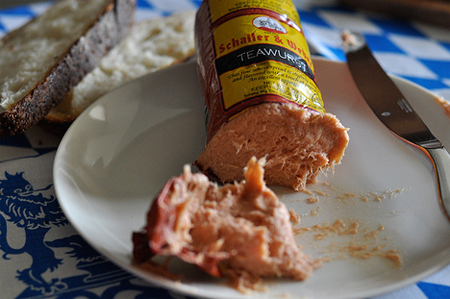On March 23, 2010, the national food surveillance system in Denmark reported a steady occurrence of positive isolates of S. Typhimurium, of unknown phage type and resistant to ampicillin, streptomycin and sulphamethoxazole, in samples from mainly pork meat and products.
Researchers from Denmark and Sweden report in Epidemiology and Infection that several isolates originated from a specific pig slaughterhouse A or a closely associated cutting plant. At this point, although no human cases had yet been identified, an investigation was initiated with the focus on food contamination. On 20 April, a total of 14 human cases with the outbreak type had been confirmed.
A case-control study was undertaken to confirm an association between illness in a subgroup of patients and consumption of teewurst or tea sausage, a spreadable sausage made from fresh salted and smoked pork and beef  which is fermented but not heat-treated. The producer of the teewurst had received pork from slaughterhouse A during the period that the outbreak strain had been isolated.
which is fermented but not heat-treated. The producer of the teewurst had received pork from slaughterhouse A during the period that the outbreak strain had been isolated.
Herds delivering pigs to slaughterhouse A were identified by a unique herd identification number given to all animal herds in Denmark.
From March 2010 and onwards, the outbreak strain was identified in a total of 113 samples; four environmental samples from slaughterhouse A and 109 meat
samples, mainly pork, of which 96 were sampled directly at slaughterhouse A or could be traced back there. Positive meat types included mainly minced pork, pork belly, pork loin and loin back ribs.
Investigation of slaughterhouse A showed positive discovery of the outbreak strain in swabs from equipment and meat samples, even after closing down production for thorough cleaning and disinfection. It was concluded that the establishment was most likely contaminated. Repeated cleaning and disinfection was performed and alterations in equipment and procedures were implemented, From the beginning of July, no further positive samples of the outbreak strain were found at slaughterhouse A.
On 8 July, a press statement was issued jointly by the DVFA and SSI, notifying the public about the salmonellosis outbreak and the link to consumption of pork meat from slaughterhouse A. In addition to describing the outbreak investigation and the action taken to control the outbreak, the statement also contained detailed guidelines on how to prevent infection with Salmonella.
A total of 172 cases of S. Typhimurium U323 were reported between March and September 2010 in Denmark demonstrating how a combination of typing Salmonella isolates from farm-to-fork and from the human population can provide early warning of a salmonellosis outbreak. It also highlights the importance of national Salmonella surveillance which allowed identification of the slaughterhouse contamination and provided the COMG with valuable information to initiate investigative measures. In spite of the existence of these systems, tracing pork meat that has entered the production chain still poses a significant challenge. If feasible, adoption of a standardized automated  system across the EU, with detailed product and distribution information, for tracing products might prove worthwhile.
system across the EU, with detailed product and distribution information, for tracing products might prove worthwhile.
Currently, this is not possible in the EU and such systems are only as good as the data provided by the operators. At present, by the time enough evidence has been gathered to issue a product recall, products with a short shelf-life (such as fresh meat) are most likely to have been consumed.
In this outbreak, early warnings from the Salmonella surveillance system were not sufficient to prevent the outbreak from lasting almost 7 months.
State-of-the-art surveillance, typing, epidemiology and food traceback allowed us to firmly establish the source of the outbreak and, in essence, solve it almost before it became evident; however, legislative measures and some delays in traceback did not allow for sufficient control, resulting in one of the longest lasting Salmonella outbreaks in Denmark.
